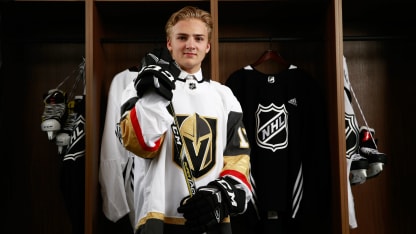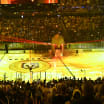As each kid filed in, the Golden Knights' staff had a revelation.
Not once.
Not twice.
But at about seven times.
Brannstrom.
Who was the toughest player "you" played against this year?
And again, Brannstrom.
Every year, an important part of the NHL Combine is each team's staff's opportunity to interview prospective draft picks. More often than not, the questions are fairly basic.
Inside Look: How NHL Combine Interviews Delivered Brannstrom To Vegas
A look behind the scenes at how interviewing his contemporaries convinced the Golden Knights to select Erik Brannstrom

By
Dan Marrazza @GoldenKnights / VegasGoldenKnights.com
-What do you think you can improve?
-What current NHL player do you compare your game to?
-What do you think you have to do to play at the NHL level?
These are the normal questions. This exercise is coupled with the players' fitness scores and bodies of work on the ice, allowing talented scouting staffs to better predict which teenage prospects will be the best players as a pros.
Most teams interview five, six and maybe even seven dozen players, despite normally only being able to select seven at the NHL Draft. More often than not, prospects' answers become repetitive.
After all, this generation of player is heavily schooled, with parents, agents and advisers having tutored the prospects in what questions to expect, as well as carefully manicured answers.
Except this year, when the Golden Knights' staff routinely mixed in the question: "who was the toughest player you played against this year?"
Meant to gauge the player they're asking, of course, but also brilliant in that it utilizes their contemporaries to gather information from a different angle about players who aren't even in the room.
RELATED: Golden Knights announce #VGKRoadTrip
Really brilliant, when you think about it.
While the Golden Knights staff conducted more than 70 interviews over the course of a week, VegasGoldenKnights.com made an astute observation when sitting in on the final afternoon.
With about 15 prospects coming in to interview that day, the most discernable takeaway was the answer to what seemed to be McPhee's staff most carefully crafted question.
As players, North Americans bound for college, Canadian juniors and mostly European players were asked, about half of the 15 interviewees cited Erik Brannstrom as the most difficult player they faced this season.
No other player was cited more than once.
Which with players having several hundred opponents to choose from, seemed a bit glaring that Brannstrom was mentioned in about 50 percent of the interviews.
This is despite the defenseman being only about 5-foot-7, and generously being listed at 175 pounds.
When the Golden Knights proceeded to draft Brannstrom 15th overall three weeks later in Chicago, as the young Swede dazzled at both Development Camp and the World Junior Summer Showcase this past week, it left us asking ourselves.
How much did these interview answers from his opponents impact Brannstrom's becoming a Golden Knight?
RELATED: Nate Schmidt signed to two-year contract
"That just helps you make your decision," Assistant Director of Player Personnel Bob Lowes said. "If his name came up and we didn't feel the same way, we wouldn't have drafted him. But we liked him.
"This just closed the loop on what we thought. It helped us make our decision on him."
As we continued speaking with Lowes about the elements that went into the Golden Knights' selection of Brannstrom, a few more interesting tidbits arose.
First, it was the reason that Brannstrom was described as so difficult to play against. That "tough to play against" wasn't a characterization of physical toughness or nastiness, as it may have originally implied.
But rather that Brannstrom's skill level was so high that despite his lack of size, opponents had such trouble predicting what his next move would be that exploiting his small stature proved to be nearly impossible.
"It's his skating ability," Lowes said. "I think what they're saying, too, is what makes it hard to play against him is you can't really get traction against him.
"Defensively, his game is really solid because of his skating ability. Even though he doesn't have that range, he does a good job with his stick. He's very strong on his stick and his skates, to win battles."
This comment led to Lowes' second point. That with the perception being that Brannstrom's game was predicated on speed, despite a seeming lack of upper-body strength, his fitness tests at the NHL Combine suggested the opposite.
RELATED: Pokey Reddick delighted by NHL's arrival in Las Vegas
That Brannstrom's lower-body tests lagged behind his upper-body tests. Which to the Golden Knights, suggested that Brannstrom's potential may even be higher than expected as his lower-body strength matures with specially designed training programs.
"He's really low all the time," Lowes said. "His balance is phenomenal. He rarely gets knocked off his skates.
"And we think he can get even stronger."
Perhaps the lone drama surrounding Brannstrom's drafting was whether he'd be available for Vegas to select.
The Golden Knights acquired the 13th and 15th overall selections (in addition to the team's original pick, sixth overall) in Expansion Draft trades, giving them two selections in the range of when they predicted Brannstrom to fall.
With the player being so highly coveted by McPhee's staff, there may have been a temptation to trade up and guarantee that Brannstrom would wind up in Vegas. Except the Golden Knights' staff's knowledge of other team's staff tipped off that this sort of transaction wouldn't be necessary.
"Knowing what other teams have done and certain areas they scout, we had a real good feeling Martin Necas was going at 12 because, for example, Robert Kron, Czech scout with Carolina, has a lot of pull there.
"You just kind of know those things. You know certain teams have certain needs. Just intel we find. Some is throwing darts, but some we could corroborate. It's a real fun exercise to do. You hope you get most of it right."
Which when Vegas' intel was proven correct with Necas going to Carolina at 12, it clearly shaped the draft board for Nick Suzuki (taken 13th) and Brannstrom (taken 15th) to fall into the Golden Knights' lap.
"We just quietly smiled to ourselves when this happened," Lowes said. "Although the feeling inside was like, 'YES!'"


















